How to Sell On Facebook Shops With Shopify For Maximum Brand Reach
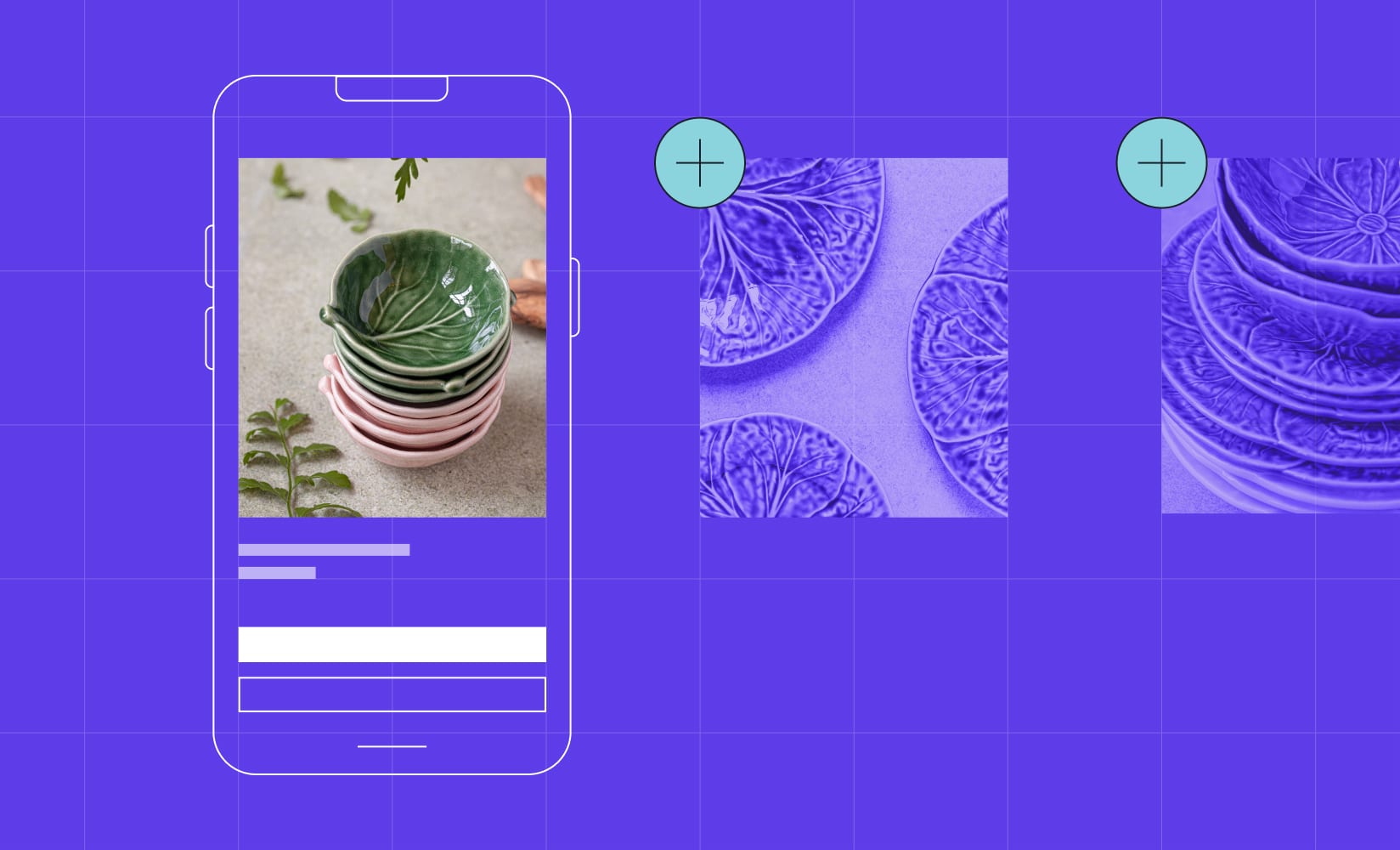
With almost 3 billion monthly active Facebook users, more than half of everyone who uses the Internet on the planet is on Facebook at least once a month.
To put that in perspective, that is more than double the entire population of North America, all checking their Facebook feed once every four weeks or so.
And with Facebook only accepting users 13 and older, almost all of them are consumers.
This is a gigantic opportunity for all direct-to-consumer (DTC) ecommerce merchants to expand their brand recognition, reach, and acquisition efforts.
In this article, we’ll cover:
Read on to learn why it’s so important to know how to sell on Facebook and use Facebook Shops with your Shopify store to supercharge sales.
#cta-visual-pb#<cta-title>Create a seamless social shopping experience<cta-title>Use Shogun Page Builder to create the perfect landing pages from your Facebook Shop.Start building for free
Facebook and ecommerce: A social media love story
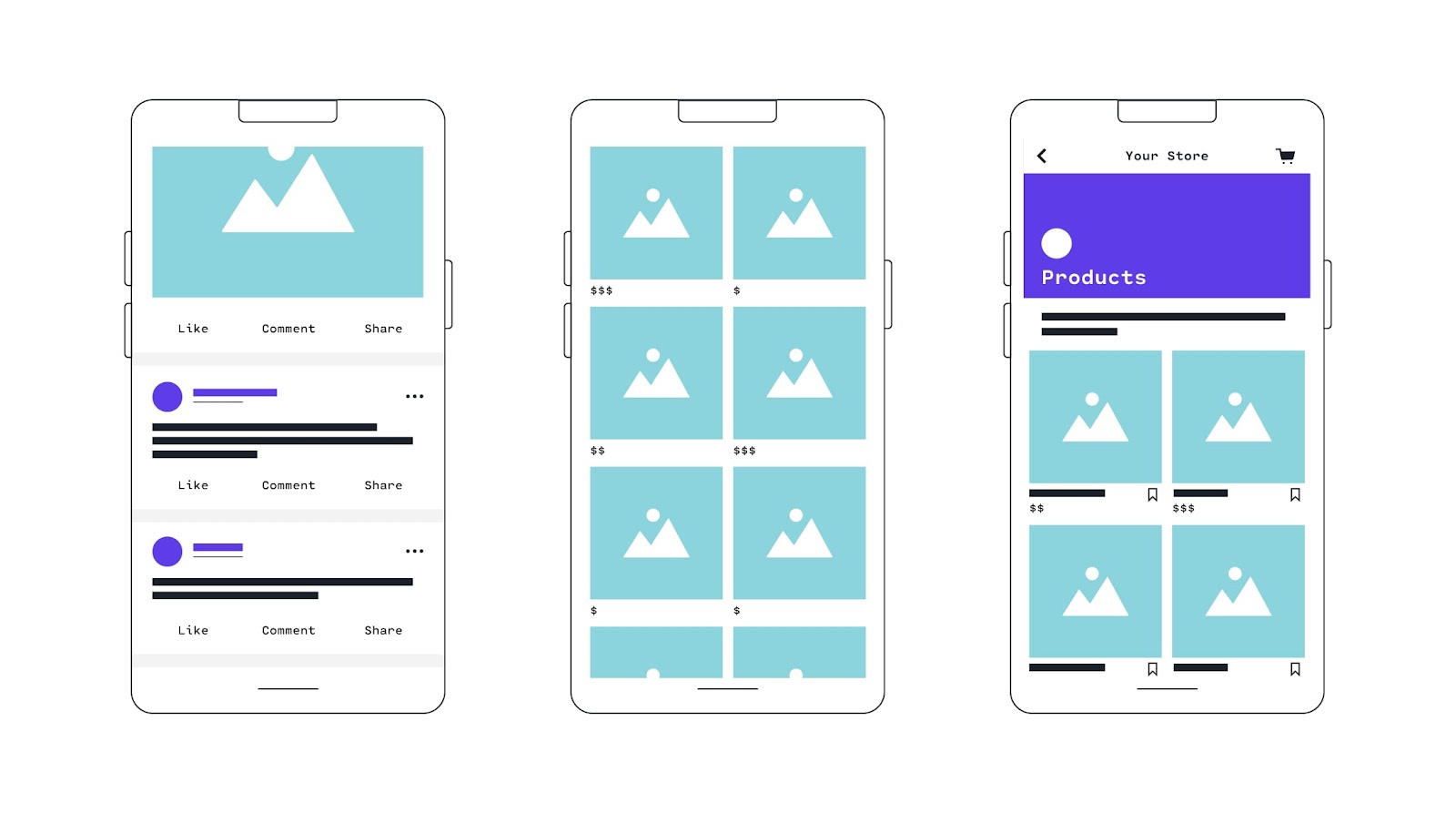
As with many communities, Facebook organically developed into a place where users could buy, sell, and trade goods.
This happened before the platform itself even created the infrastructure to support ecommerce.
There were dozens of local “buy and sell” groups, communities that organized local swap meetups, and private pages between friends and family to post spare goods.
The social media tool was versatile enough, and consumers creative enough to support local commerce on a small and unofficial scale.
Facebook Shops vs Marketplace
In 2016, Facebook created Facebook Marketplace, allowing users to browse listings from others nearby and list their own items for sale.
Thanks to Messenger, it gave Facebook users a quick way to get in touch with sellers, arrange meet-ups, and ask questions about the item.
This was and still remains an active way that individuals can list items for sale, but it wasn’t up to par when it came to established brands.
In May 2020, as the COVID-19 pandemic was coming into full swing and consumers were increasingly turning to ecommerce, Facebook announced Facebook Shops.
Facebook Shops came with new and powerful tools to enable merchants to communicate, support, and sell to customers online through their branded Facebook stores.
Merchants could upload their entire product collections, shoppers could save their favorites, and buyers could use Facebook Messenger and WhatsApp to ask questions, get updates, and more.
Today, there are more than one million active Facebook Shops and 250 monthly shoppers.
The social media platform was able to take something that had developed organically among its massive user base and build the tools to support commerce professionally and at scale.
On top of that, selling on Facebook comes with plenty of other powerful perks.
What makes Facebook such a powerful acquisition channel?
In addition to the literal country-loads of consumers using Facebook every month, Facebook comes with a built-in advertising ecosystem and discovery channel.
1. Increase product discovery
Even if you already sell on your own store—as well as marketplaces like Amazon and Walmart—there will be unique shoppers on every platform.
With so many on Facebook, you increase your chances of reaching new consumers who don’t have overlap with other marketplaces.
In addition, the Facebook algorithm is fine-tuned to deliver relevant and interesting content to consumers’ feeds, which makes your content—such as posts featuring items in your store—more likely to be seen by interested parties.
2. Improve paid ad targeting
Facebook has a sophisticated advertising ecosystem that is great at finding and learning which audience sets are most likely to convert.
Their tracking is so advanced that you can do things like target website visitors who didn’t convert by installing the Facebook Pixel, or you can swap lookalike audiences with sister brands who serve the same buyers.
All of this helps to improve your conversion rates, increase your return on ad spend (ROAS), and consistently improve your audiences. Check out some of these incredible Facebook ad examples to inspire your next ad campaign.
3. Enable a multi-channel brand experience
Facebook’s parent company, Meta, also owns channels like Instagram and WhatsApp.
As such, there’s plenty of cross-over between how shoppers can find your store and buy from you.
By selling on Facebook Shops, you can access other acquisition and communication channels to make it easier to interact with your brand and improve your multi-channel buyer experience.
Plus, it’s always nice to set things up once and have it auto-fill accurately across other channels. It helps you save time and makes your effort go even further.
4. Engage your existing customers
Facebook is an excellent place to reengage your existing customers or recapture shoppers you lost to cart abandonment.
Upon making a sale, or if a shopper isn’t ready to buy yet, encourage them to follow you on Facebook to stay in touch, access coupons, and the like.
As you post and appear on their Facebook feeds, you can tag products to entice them to buy or replenish their stocks.
5. Strengthen brand recognition
Having a strong brand identity makes your business more defensible.
Your competitors may be able to copy your sourcing and manufacturing, and even trademarks may not protect you in every market. However, competitors can never steal a brand.
Building your brand from every sales and discovery platform will strengthen your business and make your products more recognizable.
Businesses can customize the look of their Facebook Shop: You can use a cover image and accent colors that align with your unique brand.
Then you can upload your products and start selling straight away.
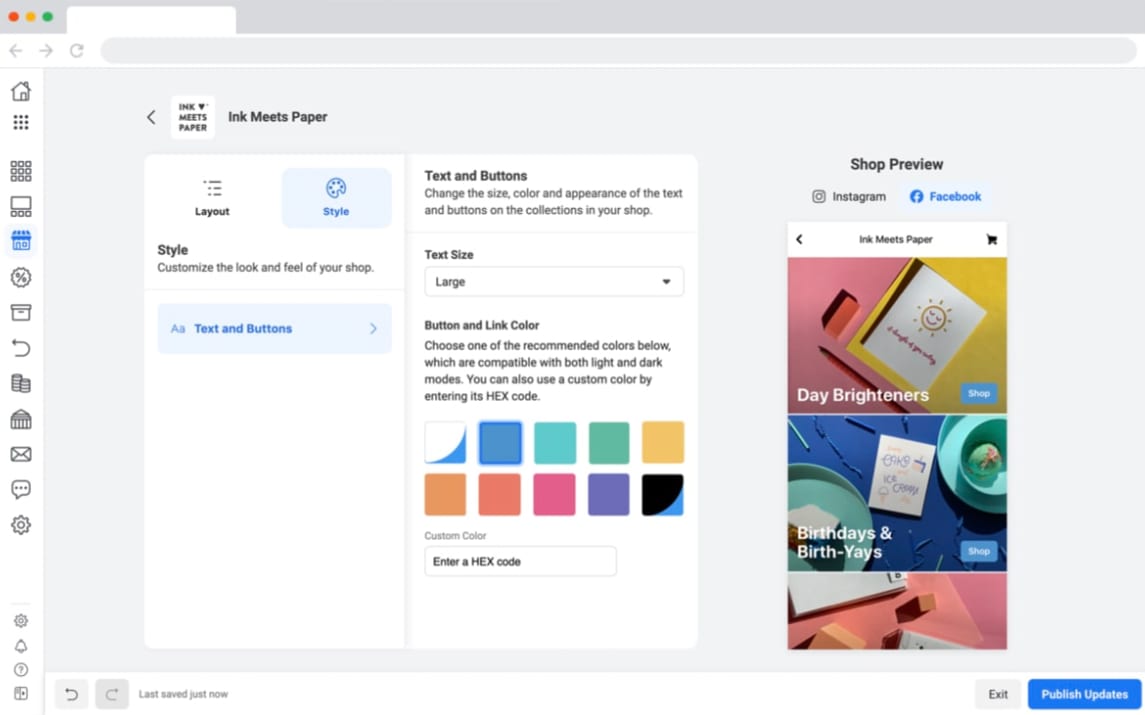
6) Provide social proof
Finally, by enabling users to comment on and share products from your Facebook Shops page, a Facebook Shop will also help you generate more social proof for your brand and products.
This, in turn, will help you convert more shoppers into customers.
#cta-visual-pb#<cta-title>Start building your store<cta-title>Try Shogun for free and start building out the perfect complement to your Facebook Shop.Start building for free
How to sell on Facebook with your Shopify store
Facebook is working with Shopify, BigCommerce, WooCommerce, Channel Advisor, CedCommerce, Cafe24, Tienda Nube, and Feedonomics to enable Facebook Shops across platforms.
Here’s how to set up a shop on Facebook:
- First, you’ll need to create a Facebook business page and catalog. You can create these when you set up your shop, or if you already have them make sure you have admin permissions before proceeding.
- Once you have that all ready, go to your Commerce Manager and click on Create Your Shop.
- Select your payment method, then the catalog you’d like to use. Be careful, as you cannot switch that catalog later on. There are three payment methods you can choose from:
- Native check-out directly within Facebook
- Messenger check-out with either Facebook Messenger or Whatsapp
- Check-out on your website, for example leading to your Shopify product pages
We recommend sending your Facebook shoppers straight to your Shopify store to check out.
This helps maintain a consistent brand experience while still giving customers the option to use Facebook as their browsing and support channel if they’d like to reach out with questions.
Tip: You can import and sync your products from Shopify with the Facebook Channel Shopify app.
How to install the Facebook channel on Shopify
Setting up your Facebook channel on Shopify is easily done in 8 quick steps.
Step 1: From your Shopify admin, click + next to SALES CHANNELS
To use Shopify with Facebook Shops, visit your Shopify dashboard and check the left-hand panel for SALES CHANNELS.
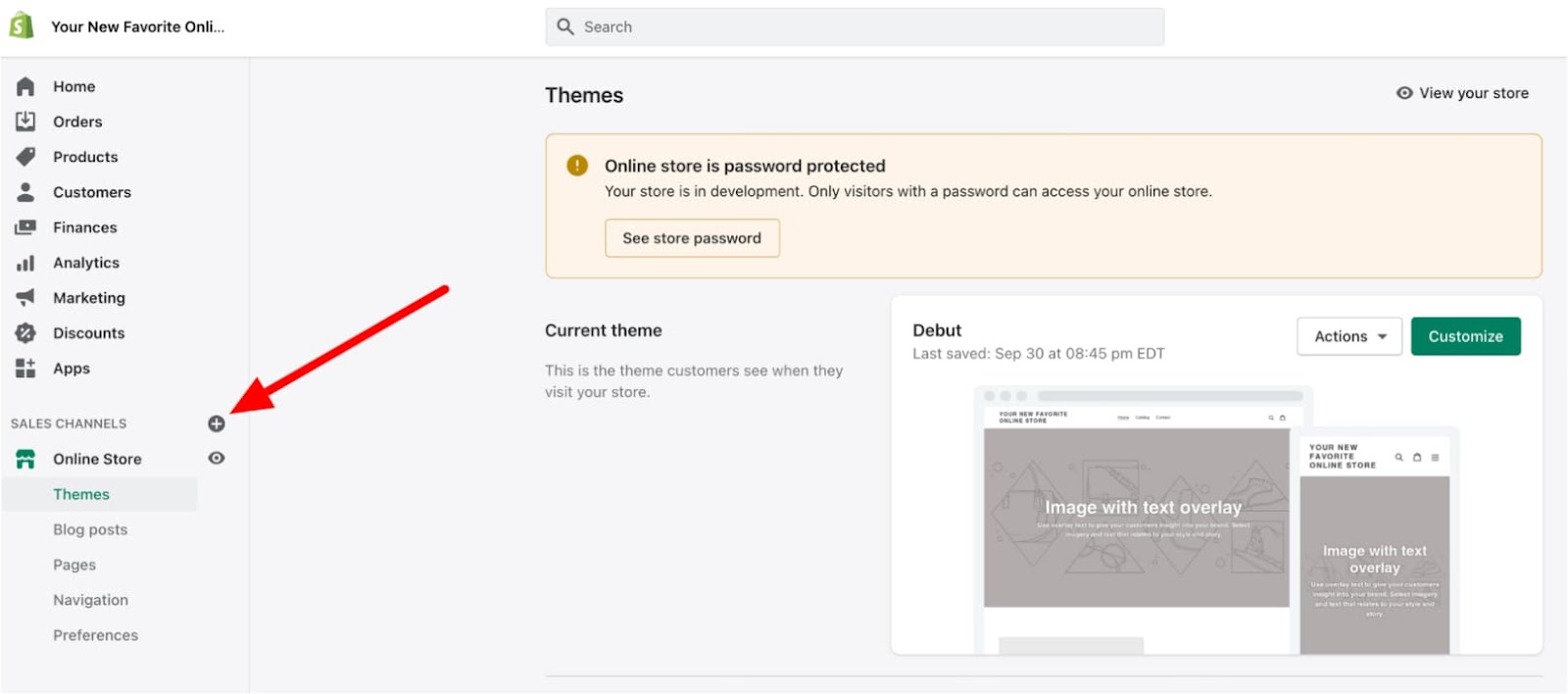
Click the + section beside SALES CHANNELS to bring up the different options.
Step 2: Click + next to Facebook, and then click Update sales channel
Click the + sign next to Facebook to select that sales channel.

Facebook should now show in your Shopify dashboard.
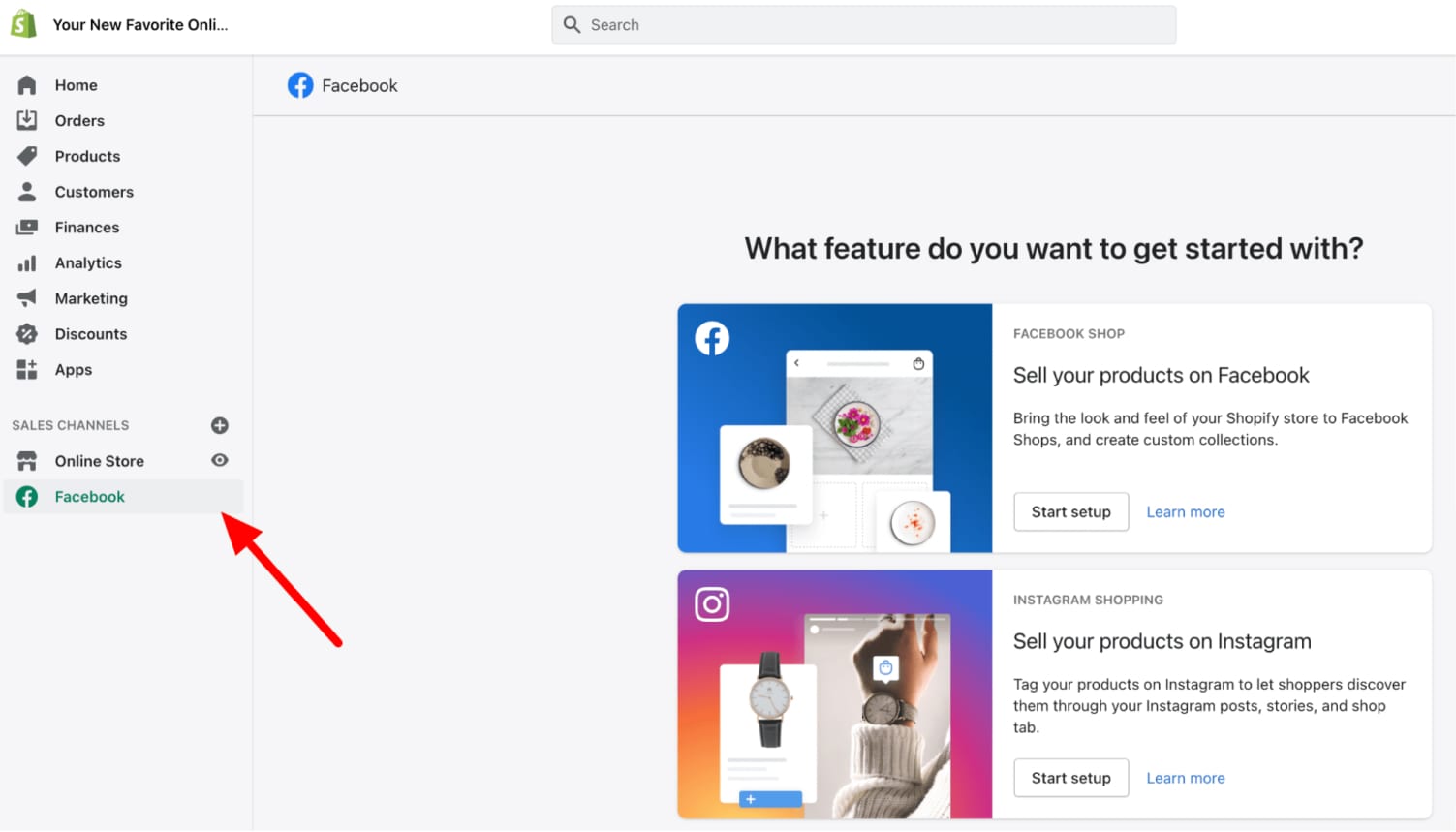
Step 3: Click Start setup on the feature that you want to install first
Click the Start setup button on the Facebook card.
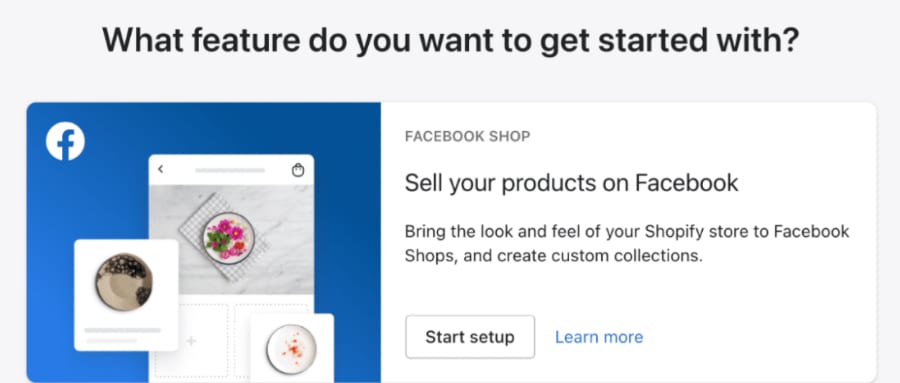
Step 4: Click Connect account
You’ll see a prompt to connect your Facebook page with Shopify. Click the Connect account button.

Create a Business Manager account (if none exists)
If you don’t already have a business manager account, you’ll be asked to create one next. This process takes place entirely on this screen.
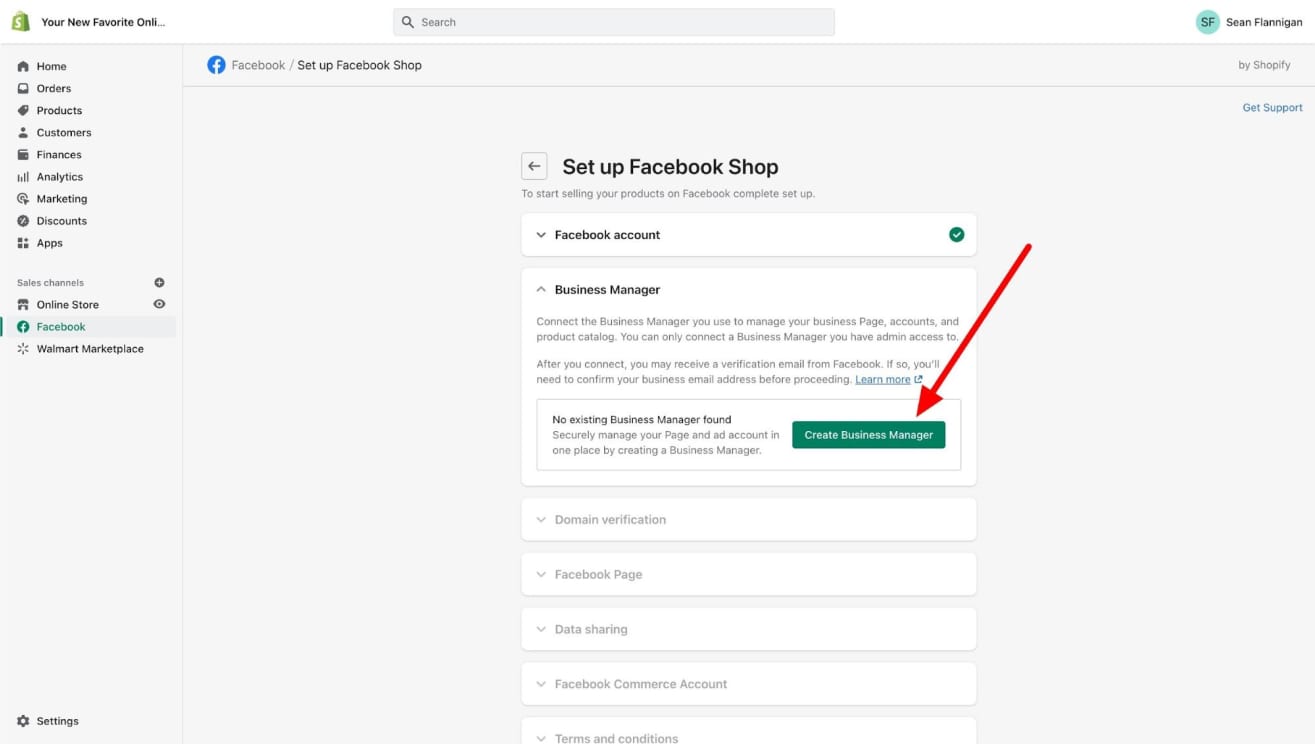
Optional: Verify your domain
You can skip domain verification, but verifying your domain helps speed up approval.
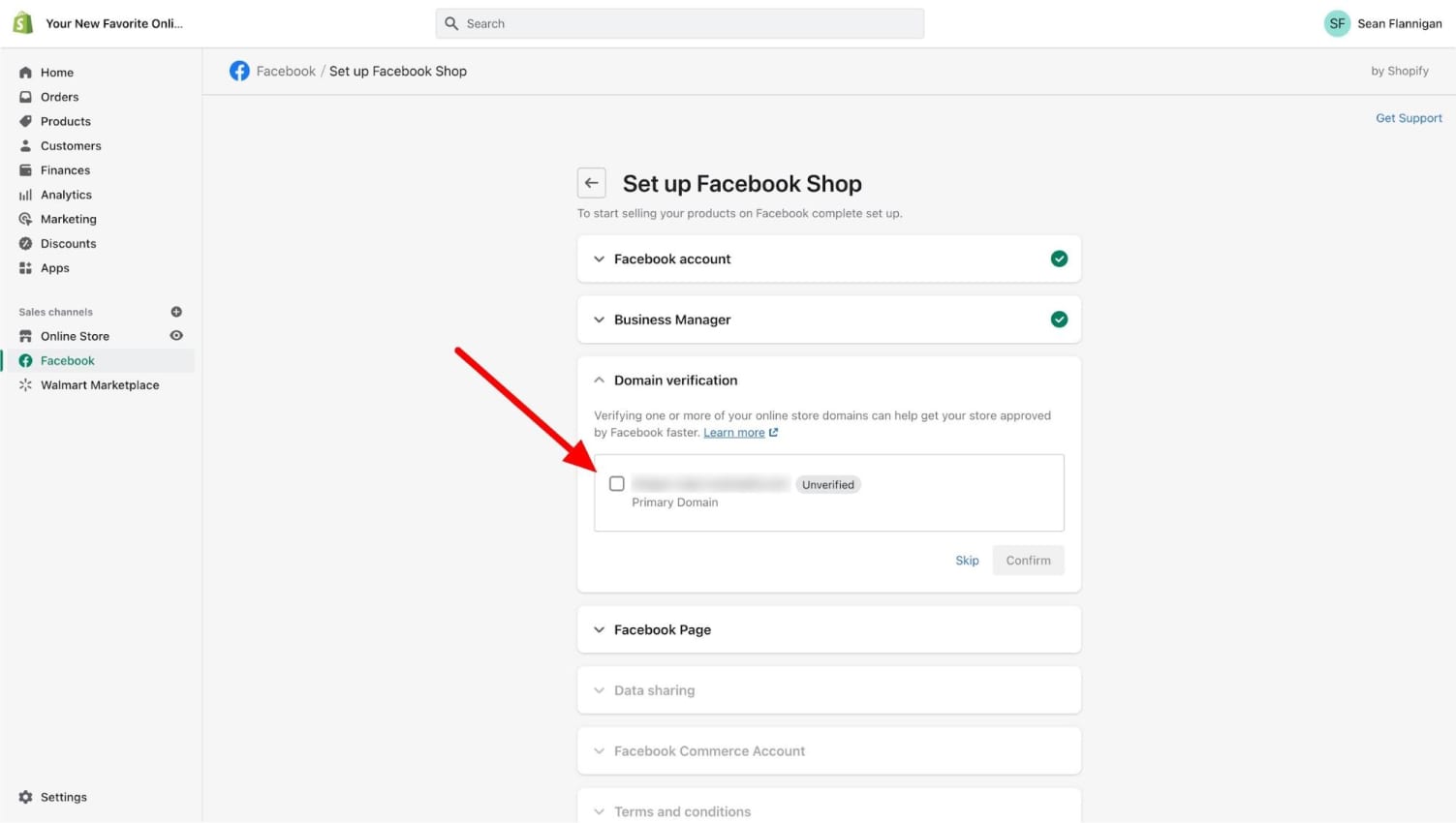
Step 5: Connect your Facebook business page
You’ll have to sign into Facebook to authorize the connection.
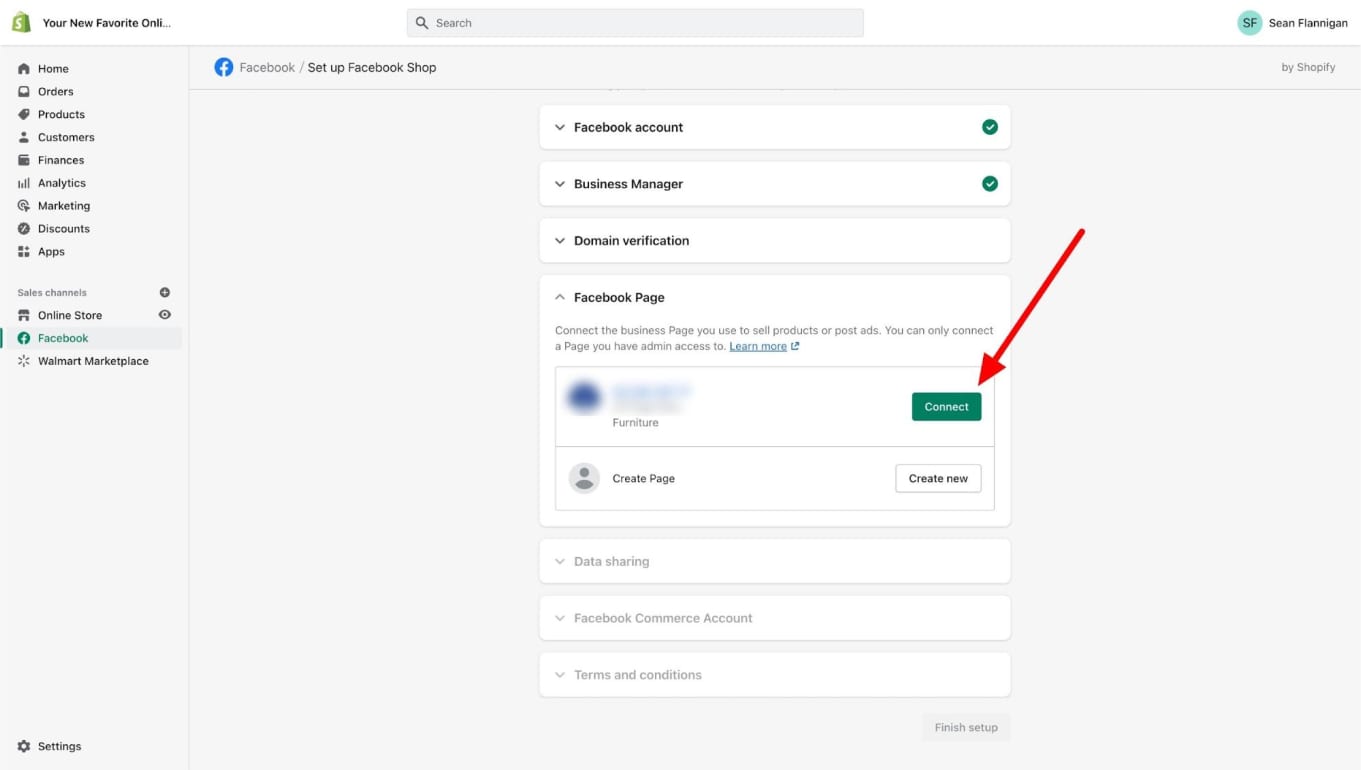
Step 6: Select your data settings
You have the option to choose your data preferences depending on how much customer data you want to share to enhance your ad performance.
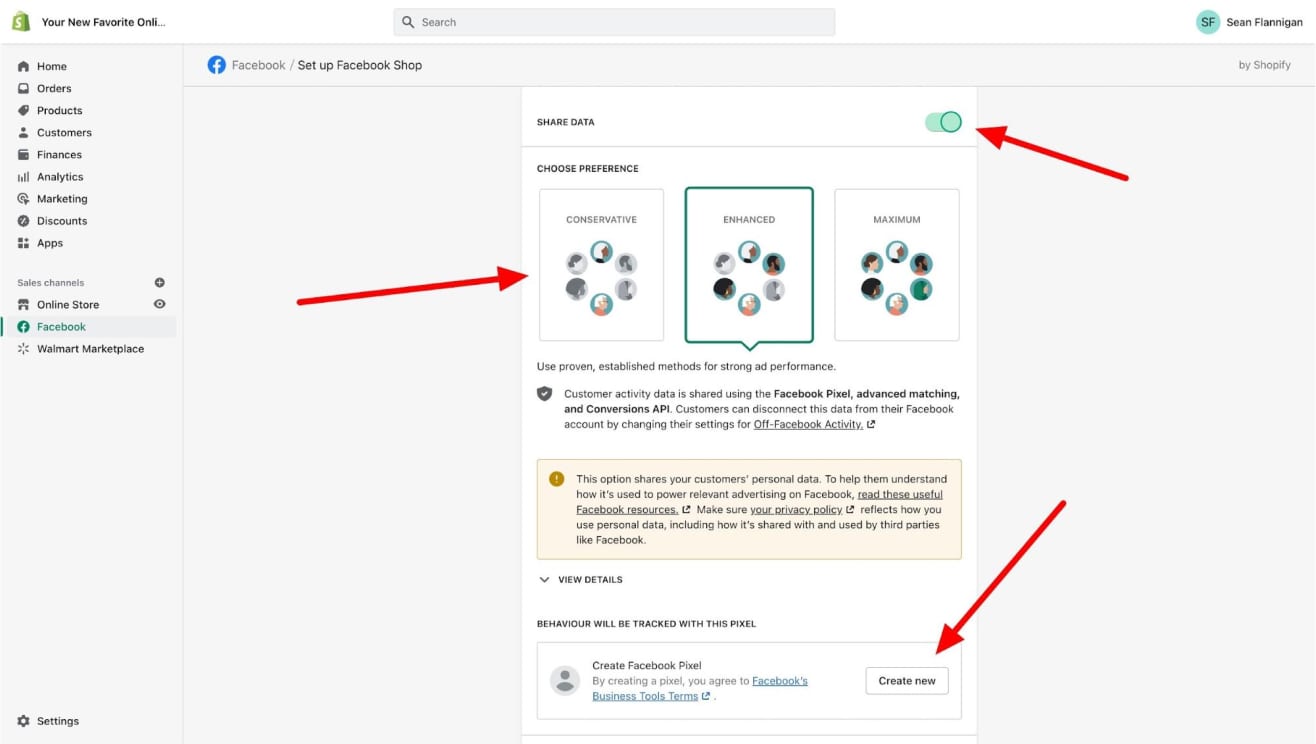
If you don’t already have a Facebook Pixel, you can create one from this screen as well.
Further reading: How to Add the Facebook Pixel to Shopify
Step 7: Create a Facebook Commerce Account.
If you are already selling on Instagram, you may already have a Facebook Commerce Account. If not, you’ll need to create one here.
You can use this account to customize your shop and collections and sell on both Meta social platforms.
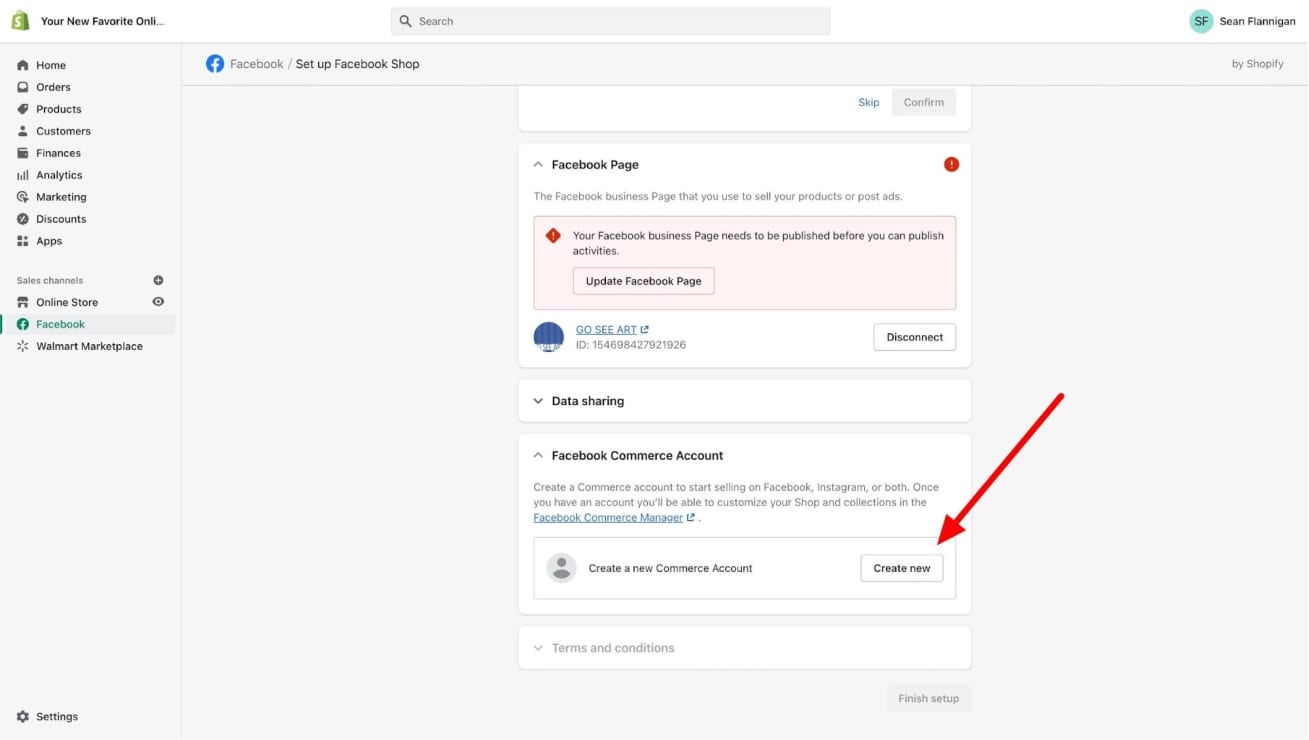
Step 8: Accept the terms and conditions.
Accept the terms and conditions of using this sales channel with Shopify to proceed.
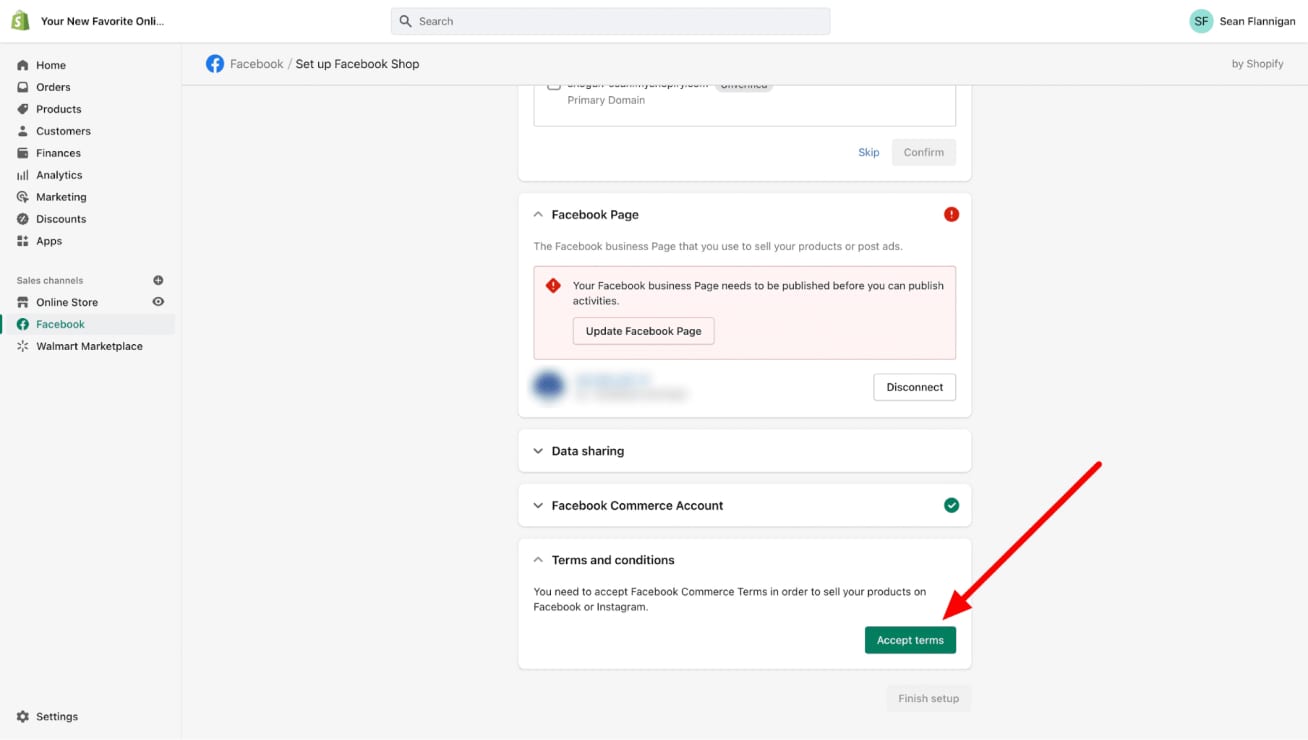
Step 9: Click Finish setup.
Finally, click on Finish setup. It could take up to 48 hours for Facebook to review and approve your products, but Shopify will send a notification email once the review process is complete.
Optional: Select which items you want to display
You don’t have to make your entire product catalog available through Facebook Shops.
You can choose which products your shoppers can purchase by going to your Products tab and navigating to All.
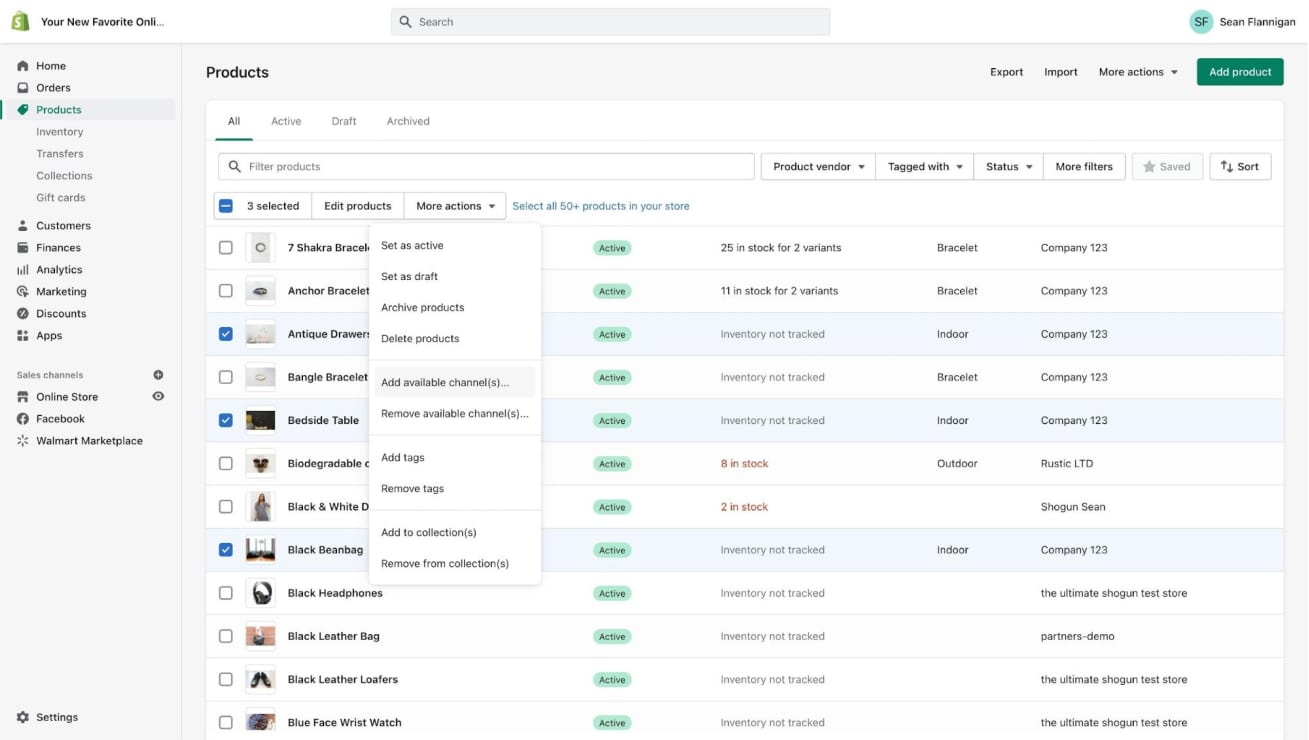
Check the products you’d like to make available, and check off which channels you want to show those products on.
Finally, click Make products available on the pop-up screen.

What are the selling fees associated with Facebook Shops?
Although it’s free to set up a Facebook Shop, there are some selling fees for using Commerce Manager to sell or allowing check-outs within Facebook.
Facebook charges a selling fee that kicks in whenever a sale is made.
Their selling fee is 5% per order or a flat fee of $0.40 on orders of $8 or less. This fee includes taxes and payment processing costs and applies to all transactions for all product categories on Facebook (and Instagram).
For example, if you sell a $10 product, they will charge a $0.50 selling fee (5% of $10). If you sell a $6 product, they will charge the $0.40 flat fee applicable to all transactions $8 and under.
Facebook also charges a chargeback fee.
That is, if any customer files a chargeback, Facebook will place a hold on your transaction until it is resolved, and any fees incurred will be billed to the merchant and appear in your financial reports.
Note: According to Facebook’s website, “We are temporarily waiving our standard selling fee for all orders marked as shipped through 11:59pm Pacific Time on June 30th, 2022.”
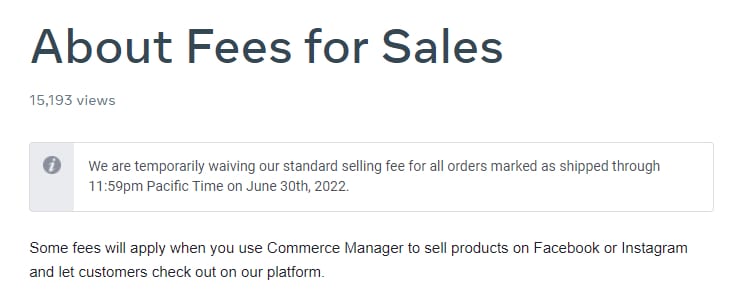
Best practices for selling on Facebook
Now that we’ve covered the why and how of selling on Facebook, let’s talk about best practices to help you level up your store.
Facebook has made creating a shop fairly accessible, so going the extra mile will help you stand out from any competitors also selling via their Facebook Shops.
Build a community
In the age of rising acquisition costs among masses of competition, it’s more important than ever to build and invest in your communities.
Having a loyal and active community is one of the most powerful tools of a strong social media presence and ecommerce brand.
Consider running regular giveaways or contests to reward loyal customers and attract new followers. You can also reward discussions and testimonials, bringing on community managers to continuously engage with and grow your communities.
Share a variety of content
Pushy posts and brands that only know how to talk about sales get old fast.
Be sure to share a variety of engaging content, from brand and product updates to lifestyle tips and other adjacent news.
For example, you might have a series of posts about a new product announcement, but pepper them with stories of how real customers are using and finding your latest release.
Leverage your customers
User-generated content (UGC) should be high on every brand’s list of things to prioritize, especially those who leverage any sort of social media to sell items and build up brand impressions.
UGC may be a little harder to gather since you’re asking for favors from your fans, but you can implement a reward or loyalty system to help incentivize more videos, posts, and reviews.
Some of the types of UGC you should request include:
- Photos and videos of customers using your product
- Video reviews of how they enjoy your product
- Lifestyle photos and posts of how your product fits into their daily lives
- Written reviews and testimonials sharing what they like best about your product
Your marketing team can then repurpose these different forms of UGC to serve different formats.
For example, if a customer sends in a testimonial on Facebook, you can add it to your website and turn it into a graphic that you can then share on Instagram.
Use humor
Don’t forget about the power of emotion when it comes to getting people on social media to take action.
If you can make them laugh, you can prompt them to follow your page for more humorous moments.
Some brands use humor as part of their brand voice; others inject small snippets to show a glimpse of personality.
Partner with the right influencers
Merchants need to be smart about the influencers they work with, but tapping into influencers—even micro-influencers with smaller audiences but higher engagement rates—can help expand your brand reach exponentially.
Instead of a slow build-up of new leads and eyeballs on your site, you suddenly get access to the full audience of a social media influencer.
Many influencers have their own creative ways to do ad reads and sponsorships that suit their unique profile.
However, some ideas you can bring up include sponsoring a livestream of them using your product, doing a Q&A with them and your brand team, or posting a before and after pic of their progress with your product.
Link your Shop Now button to Shopify
You can set up your Facebook Shop to have a main CTA to “Shop Now” that directs to your Shopify store.
This is a great way to increase conversions and click-throughs right at the onset of someone visiting your store.
Sort your items
You can organize your items into different collections to make it easier for shoppers to find what they’re looking for.
If you have any special collections or categories, we encourage you to segment them to make it easier for shoppers, especially on smaller mobile devices, to find what they want more quickly.
Highlight your key benefits
It should be easy for someone to discover your Facebook Shop, click on it, and quickly learn the key benefits and differentiators of shopping with you.
Perhaps you use all recycled materials for your packaging, or you have a lifetime warranty. Plaster this information everywhere to encourage shoppers to stick around.
Grow your audience by selling on Facebook
Facebook is a powerful tool for ecommerce sellers.
It acts as a platform to connect with customers, an advertising tool to acquire new buyers, and a sales channel to accept and streamline purchases.
When you combine Facebook and Shopify, build a community, and leverage Facebook Shops and all the tools that come with it, you can boost your conversions and brand reach to new heights.
#cta-visual-pb#<cta-title>Combine Facebook and Shopify<cta-title>Create a powerhouse acquisition and conversion flywheel with Facebook Shops and your Shopify store.Start building for free

Rachel Go
Rachel is a remote marketing manager with a background in building scalable content engines. She creates content that wins customers for B2B ecommerce companies like MyFBAPrep, Shogun, and more. In the past, she has scaled organic acquisition efforts for companies like Deliverr and Skubana.



